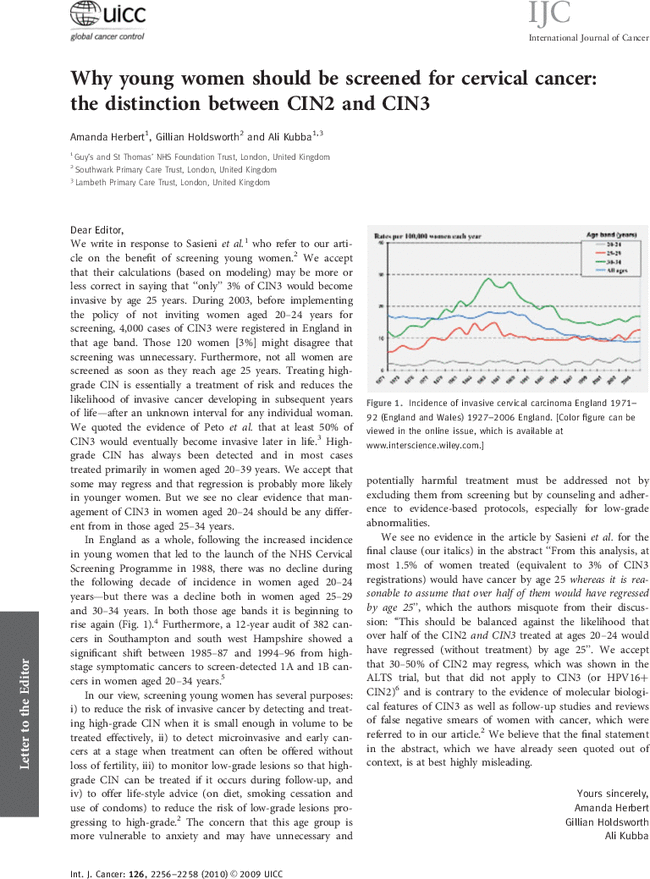Response to: Why young women should be screened for cervical cancer: The distinction between CIN2 and CIN3
Corresponding Author
Peter Sasieni
Queen Mary University of London, Cancer Research UK Centre for Epidemiology, Mathematics and Statistics, Wolfson institute of Preventive Medicine, London, United Kingdom
Queen Mary University of London, Cancer Research UK Centre for Epidemiology, Mathematics and Statistics, Wolfson Institute of Preventive Medicine, Charterhouse Square, EC1M 6BQ, London, UKSearch for more papers by this authorAlejandra Castañón
Queen Mary University of London, Cancer Research UK Centre for Epidemiology, Mathematics and Statistics, Wolfson institute of Preventive Medicine, London, United Kingdom
Search for more papers by this authorMax D. Parkin
Queen Mary University of London, Cancer Research UK Centre for Epidemiology, Mathematics and Statistics, Wolfson institute of Preventive Medicine, London, United Kingdom
Search for more papers by this authorCorresponding Author
Peter Sasieni
Queen Mary University of London, Cancer Research UK Centre for Epidemiology, Mathematics and Statistics, Wolfson institute of Preventive Medicine, London, United Kingdom
Queen Mary University of London, Cancer Research UK Centre for Epidemiology, Mathematics and Statistics, Wolfson Institute of Preventive Medicine, Charterhouse Square, EC1M 6BQ, London, UKSearch for more papers by this authorAlejandra Castañón
Queen Mary University of London, Cancer Research UK Centre for Epidemiology, Mathematics and Statistics, Wolfson institute of Preventive Medicine, London, United Kingdom
Search for more papers by this authorMax D. Parkin
Queen Mary University of London, Cancer Research UK Centre for Epidemiology, Mathematics and Statistics, Wolfson institute of Preventive Medicine, London, United Kingdom
Search for more papers by this author
References
- 1 Peto J, Gilham C, Fletcher O, Matthews FE. The cervical cancer epidemic that screening has prevented in the UK. Lancet 2004; 364: 249–56.
- 2 Parkin DM, Nguyen-Dinh X, Day NE. The impact of screening on the incidence of cervical cancer in England and Wales. Br J Obstet Gynaecol 1985; 92: 150–7.
- 3 Office for National Statistics, Cancer Statistics Registrations, 2003.
- 4 Department of Health, Cervical Screening Programme, England: 2002–03, 2003.
- 5 The Parliamentary Under-Secretary of State for Health (Ann Keen), Cervical Screening. Press Release, 29 June 2009. Available from: http://www.publications.parliament.uk/pa/cm200809/cmhansrd/cm090624/wmstext/90624m0002.htm#09062492000115.
- 6 Morrison BJ, Coldman AJ, Boyes DA, GH A. Forty years of repeated screening: the significance of carcinoma in situ. British Journal of Cancer 1996; 74: 814–19.
- 7 Moscicki AB, Shiboski S, Hills NK, Powell KJ, Jay N, Hanson EN, Miller S, Canjura-Clayton KL, Farhat S, Broering JM, Darragh TM. Regression of low-grade squamous intra-epithelial lesions in young women. Lancet 2004; 364: 1678–83.
- 8 Schlecht NF, Platt RW, Duarte-Franco E, Costa MC, Sobrinho JP, Prado JC, Ferenczy A, Rohan TE, Villa LL, Franco EL. Human papillomavirus infection and time to progression and regression of cervical intraepithelial neoplasia. J Natl Cancer Inst 2003; 95: 1336–43.
- 9 Sigurdsson K, Sigvaldason H. Is it rational to start population-based cervical cancer screening at or soon after age 20? Analysis of time trends in preinvasive and invasive diseases. Eur J Cancer 2007; 43: 769–74.
- 10Statistics Iceland [database on the Internet]2009. Available from: http://www.statice.is/pages/916.
- 11 Department of Health, Cervical Screening Programme, England: 2003–04, 2004.
- 12 The Health and Social Care Information Centre, Cervical Screening Programme, England 2007–08, October 2008.




